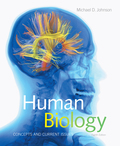
EBK HUMAN BIOLOGY
8th Edition
ISBN: 8220102019683
Author: Johnson
Publisher: PEARSON
expand_more
expand_more
format_list_bulleted
Concept explainers
Question
Chapter 19, Problem 10TY
Summary Introduction
Introduction:
Karyotyping is a procedure in which the chromosomes are observed and examined for any abnormality like an extra chromosome or structural abnormalities. These chromosomal abnormalities can lead to diseases. These chromosomes are examined when the cells are in a dividing stage.
Expert Solution & Answer
Want to see the full answer?
Check out a sample textbook solution
Students have asked these similar questions
A 25-year-old woman presents to the emergency department with a 2-day history of fever, chills, severe headache, and confusion. She recently returned from a trip to sub-Saharan Africa, where she did not take malaria prophylaxis. On examination, she is febrile (39.8°C/103.6°F) and hypotensive. Laboratory studies reveal hemoglobin of 8.0 g/dL, platelet count of 50,000/μL, and evidence of hemoglobinuria. A peripheral blood smear shows ring forms and banana-shaped gametocytes. Which of the following Plasmodium species is most likely responsible for her severe symptoms?
A.
Plasmodium vivax
B.
Plasmodium ovale
C.
Plasmodium malariae
D.
Plasmodium falciparum
Standard Concentration (caffeine) mg/L
Absorbance Reading
10
0.322
20
0.697
40
1.535
60
2.520
80
3.100
Please draw in the missing answer, thank you
Chapter 19 Solutions
EBK HUMAN BIOLOGY
Ch. 19 - If you might be a carrier of a gene for an...Ch. 19 - Prob. 2QCCh. 19 - Prob. 1CRCh. 19 - Prob. 2CRCh. 19 -
3. Distinguish between genotype and phenotype.
Ch. 19 - Describe the contributions of Mendel to the field...Ch. 19 - Explain how alterations of chromosome number and...Ch. 19 - Prob. 6CRCh. 19 - Prob. 7CRCh. 19 - Describe what is meant by sex-linked inheritance.
Ch. 19 -
9. Explain why lethal diseases caused by dominant...Ch. 19 - Prob. 10CRCh. 19 - All of the following statements about homologous...Ch. 19 - Prob. 2TYCh. 19 -
3. Which of the following statements correctly...Ch. 19 - Prob. 4TYCh. 19 - Prob. 5TYCh. 19 - Prob. 6TYCh. 19 - Prob. 7TYCh. 19 - Which of the following results in the separation...Ch. 19 - Prob. 9TYCh. 19 - Prob. 10TYCh. 19 - What tool is used to determine the probabilities...Ch. 19 - Prob. 12TYCh. 19 - What is the basis for the tremendous genetic...Ch. 19 - Prob. 14TYCh. 19 -
15. Which of the following events or processes...Ch. 19 -
1. What fraction of the offspring of two...Ch. 19 -
2. Why is it that the range of resting blood...Ch. 19 - Prob. 3AWKCh. 19 - Geneticists often study patterns of gene transfer...Ch. 19 - Prob. 5AWKCh. 19 - Prob. 6AWKCh. 19 - Nondisjunction during meiosis can lead to the...
Knowledge Booster
Learn more about
Need a deep-dive on the concept behind this application? Look no further. Learn more about this topic, biology and related others by exploring similar questions and additional content below.Similar questions
- a. On this first grid, assume that the DNA and RNA templates are read left to right. DNA DNA mRNA codon tRNA anticodon polypeptide _strand strand C с A T G A U G C A TRP b. Now do this AGAIN assuming that the DNA and RNA templates are read right to left. DNA DNA strand strand C mRNA codon tRNA anticodon polypeptide 0 A T G A U G с A TRParrow_forwardplease answer all question below with the following answer choice, thank you!arrow_forwardplease draw in the answeres, thank youarrow_forward
- A) What is being shown here?B) What is indicated by the RED arrow?C) What is indicated by the BLUE arrow?arrow_forwardPlease identify the curve shown below. What does this curve represent? Please identify A, B, C, D, and E (the orange oval). What is occurring in these regions?arrow_forwardPlease identify the test shown here. 1) What is the test? 2) What does the test indicate? How is it performed? What is CX? 3) Why might the test be performed in a clinical setting? GEN CZ CX CPZ PTZ CACarrow_forward
- Determine how much ATP would a cell produce when using fermentation of a 50 mM glucose solution?arrow_forwardDetermine how much ATP would a cell produce when using aerobic respiration of a 7 mM glucose solution?arrow_forwardDetermine how much ATP would a cell produce when using aerobic respiration to degrade one small protein molecule into 12 molecules of malic acid, how many ATP would that cell make? Malic acid is an intermediate in the Krebs cycle. Assume there is no other carbon source and no acetyl-CoA.arrow_forward
arrow_back_ios
SEE MORE QUESTIONS
arrow_forward_ios
Recommended textbooks for you
 Biology (MindTap Course List)BiologyISBN:9781337392938Author:Eldra Solomon, Charles Martin, Diana W. Martin, Linda R. BergPublisher:Cengage Learning
Biology (MindTap Course List)BiologyISBN:9781337392938Author:Eldra Solomon, Charles Martin, Diana W. Martin, Linda R. BergPublisher:Cengage Learning Principles Of Radiographic Imaging: An Art And A ...Health & NutritionISBN:9781337711067Author:Richard R. Carlton, Arlene M. Adler, Vesna BalacPublisher:Cengage Learning
Principles Of Radiographic Imaging: An Art And A ...Health & NutritionISBN:9781337711067Author:Richard R. Carlton, Arlene M. Adler, Vesna BalacPublisher:Cengage Learning Medical Terminology for Health Professions, Spira...Health & NutritionISBN:9781305634350Author:Ann Ehrlich, Carol L. Schroeder, Laura Ehrlich, Katrina A. SchroederPublisher:Cengage Learning
Medical Terminology for Health Professions, Spira...Health & NutritionISBN:9781305634350Author:Ann Ehrlich, Carol L. Schroeder, Laura Ehrlich, Katrina A. SchroederPublisher:Cengage Learning


Biology (MindTap Course List)
Biology
ISBN:9781337392938
Author:Eldra Solomon, Charles Martin, Diana W. Martin, Linda R. Berg
Publisher:Cengage Learning

Principles Of Radiographic Imaging: An Art And A ...
Health & Nutrition
ISBN:9781337711067
Author:Richard R. Carlton, Arlene M. Adler, Vesna Balac
Publisher:Cengage Learning


Medical Terminology for Health Professions, Spira...
Health & Nutrition
ISBN:9781305634350
Author:Ann Ehrlich, Carol L. Schroeder, Laura Ehrlich, Katrina A. Schroeder
Publisher:Cengage Learning
